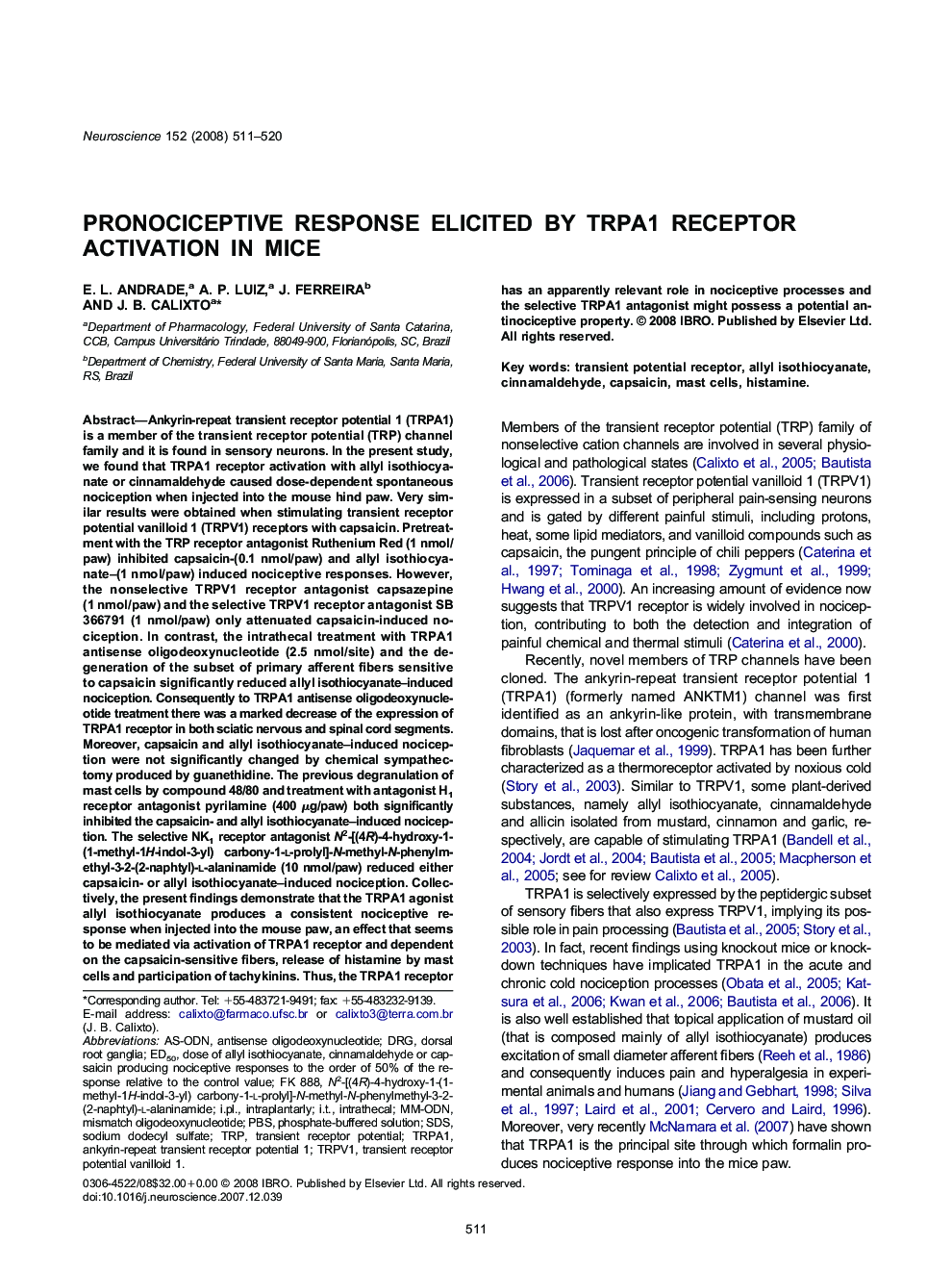| کد مقاله | کد نشریه | سال انتشار | مقاله انگلیسی | نسخه تمام متن |
|---|---|---|---|---|
| 4340668 | 1295806 | 2008 | 10 صفحه PDF | دانلود رایگان |
عنوان انگلیسی مقاله ISI
Pronociceptive response elicited by TRPA1 receptor activation in mice
دانلود مقاله + سفارش ترجمه
دانلود مقاله ISI انگلیسی
رایگان برای ایرانیان
کلمات کلیدی
PBSAS-ODNTRPA1TRPV1SDSDRGTrpi.pl.ED50Antisense oligodeoxynucleotide - oligodeoxynucleotide antisensei.t. - آی تی.Allyl isothiocyanate - ایزوتیوسیانات آللییلintrathecal - اینتراکتالsodium dodecyl sulfate - سدیم دودسیل سولفاتCinnamaldehyde - سینامالدهید Mast cells - ماست سل هاphosphate-buffered solution - محلول بافر فسفاتHistamine - هیستامینtransient receptor potential - پتانسیل گیرنده گذراTransient receptor potential vanilloid 1 - پتانسیل گیرنده گذرا وانیلیوئید 1Capsaicin - کپسایسین یا کاپسیسینdorsal root ganglia - گانگلیس ریشه پشتی
موضوعات مرتبط
علوم زیستی و بیوفناوری
علم عصب شناسی
علوم اعصاب (عمومی)
پیش نمایش صفحه اول مقاله

چکیده انگلیسی
Ankyrin-repeat transient receptor potential 1 (TRPA1) is a member of the transient receptor potential (TRP) channel family and it is found in sensory neurons. In the present study, we found that TRPA1 receptor activation with allyl isothiocyanate or cinnamaldehyde caused dose-dependent spontaneous nociception when injected into the mouse hind paw. Very similar results were obtained when stimulating transient receptor potential vanilloid 1 (TRPV1) receptors with capsaicin. Pretreatment with the TRP receptor antagonist Ruthenium Red (1 nmol/paw) inhibited capsaicin-(0.1 nmol/paw) and allyl isothiocyanate-(1 nmol/paw) induced nociceptive responses. However, the nonselective TRPV1 receptor antagonist capsazepine (1 nmol/paw) and the selective TRPV1 receptor antagonist SB 366791 (1 nmol/paw) only attenuated capsaicin-induced nociception. In contrast, the intrathecal treatment with TRPA1 antisense oligodeoxynucleotide (2.5 nmol/site) and the degeneration of the subset of primary afferent fibers sensitive to capsaicin significantly reduced allyl isothiocyanate-induced nociception. Consequently to TRPA1 antisense oligodeoxynucleotide treatment there was a marked decrease of the expression of TRPA1 receptor in both sciatic nervous and spinal cord segments. Moreover, capsaicin and allyl isothiocyanate-induced nociception were not significantly changed by chemical sympathectomy produced by guanethidine. The previous degranulation of mast cells by compound 48/80 and treatment with antagonist H1 receptor antagonist pyrilamine (400 μg/paw) both significantly inhibited the capsaicin- and allyl isothiocyanate-induced nociception. The selective NK1 receptor antagonist N2-[(4R)-4-hydroxy-1-(1-methyl-1H-indol-3-yl) carbony-1-l-prolyl]-N-methyl-N-phenylmethyl-3-2-(2-naphtyl)-l-alaninamide (10 nmol/paw) reduced either capsaicin- or allyl isothiocyanate-induced nociception. Collectively, the present findings demonstrate that the TRPA1 agonist allyl isothiocyanate produces a consistent nociceptive response when injected into the mouse paw, an effect that seems to be mediated via activation of TRPA1 receptor and dependent on the capsaicin-sensitive fibers, release of histamine by mast cells and participation of tachykinins. Thus, the TRPA1 receptor has an apparently relevant role in nociceptive processes and the selective TRPA1 antagonist might possess a potential antinociceptive property.
ناشر
Database: Elsevier - ScienceDirect (ساینس دایرکت)
Journal: Neuroscience - Volume 152, Issue 2, 18 March 2008, Pages 511-520
Journal: Neuroscience - Volume 152, Issue 2, 18 March 2008, Pages 511-520
نویسندگان
E.L. Andrade, A.P. Luiz, J. Ferreira, J.B. Calixto,